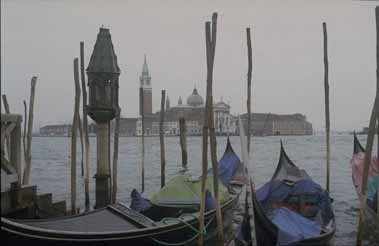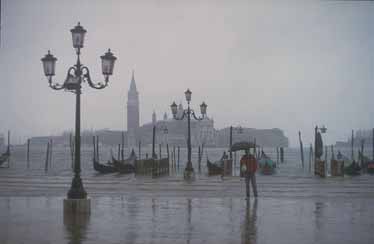

 He moved close to the Madonna with the intention of leaning the metal tube
against the wall alongside her. In fact he was beginning to bend forward to
do this. His eyes were on the statue still but he was on the point of
looking away to where he was intending to place the spray. His face was very
near the folds of the Madonna's robe, where they gathered at the waist, too
near to see any form or human likeness, only the ancient enduring grain of
the stone. It was then, at the moment he had relaxed attention, was on the
point of looking away, perhaps had already begun to do so, that a sudden
sense of being quite in the open, without protection, descended on him,
accompanied by a strong sensation of space and silence, and a feeling of
threatened balance which made him clutch for the rail. He had a fleeting
impression of light but he was not in it, or not quite in it, a long
straight shadow across the light, two human bodies, naked and gleaming wet,
part in light and part in shadow, standing together, but not very close, and
some sort of echo or resonance, perhaps of voices, but no words. The
impression was a strangely piercing one, perhaps because of the hush that
seemed to surround it, but it was over at once, before his own body had
achieved a stiffening of surprise. He found himself holding tightly to the
scaffold rail. The wet Madonna was again before him. With conscious care he
leaned forward to place the spray against the wall.
He moved close to the Madonna with the intention of leaning the metal tube
against the wall alongside her. In fact he was beginning to bend forward to
do this. His eyes were on the statue still but he was on the point of
looking away to where he was intending to place the spray. His face was very
near the folds of the Madonna's robe, where they gathered at the waist, too
near to see any form or human likeness, only the ancient enduring grain of
the stone. It was then, at the moment he had relaxed attention, was on the
point of looking away, perhaps had already begun to do so, that a sudden
sense of being quite in the open, without protection, descended on him,
accompanied by a strong sensation of space and silence, and a feeling of
threatened balance which made him clutch for the rail. He had a fleeting
impression of light but he was not in it, or not quite in it, a long
straight shadow across the light, two human bodies, naked and gleaming wet,
part in light and part in shadow, standing together, but not very close, and
some sort of echo or resonance, perhaps of voices, but no words. The
impression was a strangely piercing one, perhaps because of the hush that
seemed to surround it, but it was over at once, before his own body had
achieved a stiffening of surprise. He found himself holding tightly to the
scaffold rail. The wet Madonna was again before him. With conscious care he
leaned forward to place the spray against the wall.
 Tomorrow, back to work on the Madonna. The lower folds of her robe have been
done now, up to a level just above the knees. All this is white and
splendid. I am nervous still about the upper parts, especially the hands and
head. But the quartz-cutter is working wonderfully well. One must of course
restrain the impulse to hurry. It is natural to want to get the whole form
renewed. But any smallest area missed or skimped now will not absorb the
conserver and that could jeopardize the whole value of the restoration. So
patience is the order of the day. She has been patient enough, after
all. È la parte esposta, as Signor Biagi said. No sickliness
there about fruit. Christ of course the spiritual fruit of the Madonna's
womb. But she was not supposed to be an individual, merely a set of
attributes for veneration.
Tomorrow, back to work on the Madonna. The lower folds of her robe have been
done now, up to a level just above the knees. All this is white and
splendid. I am nervous still about the upper parts, especially the hands and
head. But the quartz-cutter is working wonderfully well. One must of course
restrain the impulse to hurry. It is natural to want to get the whole form
renewed. But any smallest area missed or skimped now will not absorb the
conserver and that could jeopardize the whole value of the restoration. So
patience is the order of the day. She has been patient enough, after
all. È la parte esposta, as Signor Biagi said. No sickliness
there about fruit. Christ of course the spiritual fruit of the Madonna's
womb. But she was not supposed to be an individual, merely a set of
attributes for veneration.
Her right leg, the one that is advanced, is
given a definite prominence against the drapery, and the limb itself is
quite robust and substantial and moulded very plastically, almost as if it
was done by abrasion rather than cutting. Great care has gone into the
moulding of this right leg and the only significant movement of the drapery
in the area is a long diagonal fold, not very deep - five or six inches
going from just below the kneecap to the beginning of the convex line of the
calf, on the inside of the leg. This fold does nothing to conceal the
details of the leg. In fact it rather sensuously emphasizes them. The left
leg of course is masked by the drapery and not articulated.
The Gothic movement is implicit in this right
leg and in the way the drapery is used not to enhance volume, as it was in
the Venetian sculpture of the time, but to accentuate the line. Something
of Nino Pisano there in the clinging lines of the robe? Certainly Pisano
influenced the Dalle Masegne brothers and they worked in Bologna and Venice.
Milan too, I think. So a line from Pisano through the Dalle Masegne to some
northern Italian sculptor of the next generation?
Barry Unsworth




